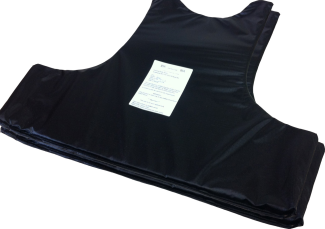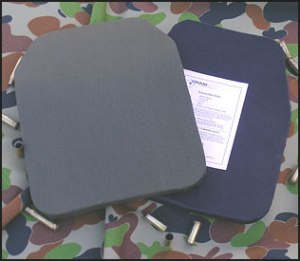 I get this question sometimes from students in my classes, and by e-mail from people who read this blog. So, as an average prepper (if there is such a thing) should you spend the money and effort to get body armor, and if so, what kind? For those who have not been trained in body armor use, there are a lot of misconceptions about this subject.
I get this question sometimes from students in my classes, and by e-mail from people who read this blog. So, as an average prepper (if there is such a thing) should you spend the money and effort to get body armor, and if so, what kind? For those who have not been trained in body armor use, there are a lot of misconceptions about this subject.
First of all, there is no such thing as a “bullet proof vest”. Body armor is categorized according to the level of protection that is based on the type of ammunition they will protect against. I read a lot from armchair generals who insist that you must have the highest level of body armor protection available, I.E. will stop 5.56mm and 7.62mm. armor-piercing or why waste the time. Evidently none of these heroes have ever worn this type of armor anywhere other than the dressing room of their local police supply shop. I have. I am not going to go into the large variety of body armor available. I want to discuss concepts so you can understand what you may or may not need/want.
Up to level IIIA, body armor is generally made of woven Kevlar panels. Higher levels will consist of insertable plates made of steel or ceramic.
First lets look at how body armor is rated according to levels of protection, according to the National Institute of Justice rating scheme.
Level IIA: Will protect against most handguns (not 44 magnums and larger). It is the thinnest and lightest armor.
Level IIIA will stop all handgun rounds, even if fired out of sub machine guns .Will stop shotguns with buckshot.
Level III is when you start the ability to stop rifle bullets and are traditionally hard body armor. Level III armor will stop military 5.56, 7.62 , and 308 . Basically Level III will stop most rifle rounds that are not armor piercing.
Level IV armor will stop armor-piercing bullets.
For more detailed information, check out the National Institute of Justice website. You can download a pdf document that will tell you more about body armor than you probably want to know.
Keep in mind, when we are talking protection, we are talking penetration. Bullets will not bounce off of your armor like you were Superman. Getting a solid torso hit with a high-caliber round, even when wearing a vest rated to stop it, is going to hurt. A lot. And may cause internal damage.
So, should you consider body armor in your preps? What threats are you expecting? Are you anticipating a sustained shoot out with heavily armed opponents? Does your prep plan include the weight of this type of armor ?
While contracting in Afghanistan , the Department of State issued us level IIIA vests and Level IV plate inserts. Protection up to 7.62mm armor piercing. I wore my own IIIA vest and had a local taylor reinforce the bottom seams of the carrier so I could insert the hard plates. The whole set weighed at least 25lbs. Trust me, with all of the other gear I was also carrying, I was sweating like a harlot at a Baptist convention. This level of armor is heavy. Do you really need that? And are you prepared for the limitations of speed of movement it carries? Have you thought about the amount of attention that this level of body armor would bring you? Body armor is like most things in your kit. If you don’t have it with you when you need it, you wasted your time.
and Level IV plate inserts. Protection up to 7.62mm armor piercing. I wore my own IIIA vest and had a local taylor reinforce the bottom seams of the carrier so I could insert the hard plates. The whole set weighed at least 25lbs. Trust me, with all of the other gear I was also carrying, I was sweating like a harlot at a Baptist convention. This level of armor is heavy. Do you really need that? And are you prepared for the limitations of speed of movement it carries? Have you thought about the amount of attention that this level of body armor would bring you? Body armor is like most things in your kit. If you don’t have it with you when you need it, you wasted your time.
If you are planning on staying in a fixed, fortified bug out location, then heavy armor might be useful if you wanted to spend the money on it. But for most preppers, this level of protection is neither needed nor feasible. A more practical approach might be a IIA or IIIA panel set that you could wear under your clothes to be inconspicuous or outside your clothing if you were not worried about people noticing.
If you decide that body armor should be part of your preps, then do your research and buy wisely.
As I was reading I was thinking about weight and only weight.
In my youth we had to wear BA aka flack jackets.
Right until someone got one in the groin and one high up into the armpit through the upper arm..
At that point we all rebelled knowing full well that our movement was severely hampered, it weighed a ton, and was about as much good as a chocolate teapot against mines, hat pins through the testicles, and anyone who knew anything about accurate shooting.
In later years in civvie security I wore stab vests.
I don’t know why it was SOP as the local hooligans all took classes on how to slash the femoral or brancial artery.
Is armor desirable?
If someone is spraying you the damage done to your extremities can be enough to ruin your day and, for old farts like me, I prefer the ability of drop and roll into suitable cover than weighing me down.
Except during practice IA drills, that REALLY hurts now!!!
LikeLiked by 1 person
Those of us who have been there know that this is a trade off. Like you, I prefer the ability to move rapidy over being weighted down. Armor of all types is always a two way street. In Vietnam, the Marines were required to wear flak jackets while we in the Army were not. The 101st ABN. was insistent on us wearing helmets while in the jungle. The old G.I. steel pot was good to cook and wash in but a real pain in the butt to wear. I could never get one not to wobble on my head. It interfered with both hearing and vision. Most of us just tied them off on our rucksacks and wore the soft boonie hat unless we thought things were aboout to get real serious. In Afghanistan we laughed that we were walking organ donnors. An IED would remove our heads, arms and legs, but our internal organs were safely armored to be recycled.
LikeLiked by 1 person
Yep, and had to scoop the bits.
Yet to translate that experience onto the streets of say the US is difficult. In the UK it’s totally alien to most.
Everyone seems to love the idea of wearing a vest, few understand the practicality and limitations. The few being those who wore them for real.
Personally I blame the prepper ex-spurts and their (Click here for on-line sales)
Carry on with the good work Sir.
LikeLiked by 1 person